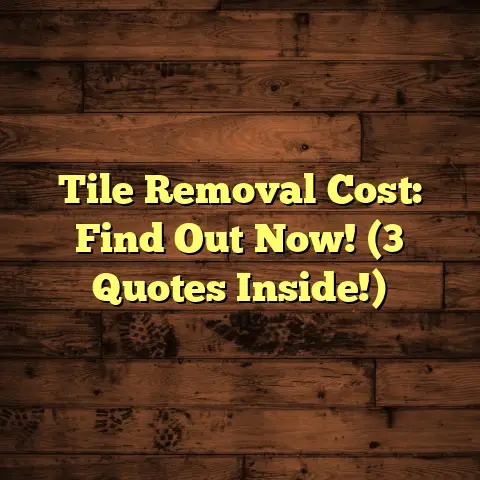Does LVP Flooring Need To Acclimate? (24 Hour Rule!)
Imagine you’ve just purchased a beautiful luxury vinyl plank (LVP) flooring to transform your living space.
The colors, textures, and patterns are perfect for your home, and you can hardly wait to install it.
But as you read the installation guidelines, you stumble upon a crucial question: does this flooring really need to acclimate to your home environment?
You’ve heard mixed opinions from friends, contractors, and online forums—some insist that acclimation is essential, while others claim it’s unnecessary and a waste of time.
This dilemma leaves you wondering: should you wait 24 hours for your new flooring to adjust to the temperature and humidity of your home, or can you dive straight into the installation?
1. It’s your favorite flooring contractor here, ready to dive deep into a topic that often causes confusion: acclimation of luxury vinyl plank (LVP) flooring.
LVP has exploded in popularity over the
last decade, and for good reason.
It’s durable, water-resistant, and looks
amazing.
But with its rise, so have the questions surrounding proper installation, especially the infamous “24 hour rule.”
Why does acclimation matter anyway?
Well, imagine investing in a stunning
new floor, only to find it buckling or
gapping a few weeks later.
Not fun, right?
Understanding the 24 hour rule can save you a ton of headaches and ensure your LVP floor looks fantastic for years to come.
So, let’s get into it and see if this rule is a myth or must-do.
2. What Is LVP Flooring?
Let’s start with the basics. What exactly is LVP flooring?
Simply put, it’s a multi-layered synthetic flooring product designed to mimic the look of natural materials like hardwood, stone, or ceramic tile.
Think of it as the chameleon of the flooring world – highly adaptable and stylish.
Benefits of LVP:
- Water Resistance:
Unlike traditional hardwood, LVP is
highly resistant to water, making it
perfect for bathrooms, kitchens, and
basements. - Durability:
LVP is incredibly tough and can withstand
heavy foot traffic, scratches, and dents. - Ease of Installation:
Many LVP products come with click-lock
systems, making DIY installation a breeze. - Cost-Effectiveness:
LVP often provides the look of high-end
materials at a fraction of the cost. - Design Versatility:
Available in countless styles, colors,
and patterns, LVP can complement any
décor.
There are generally two main types of LVP:
- Rigid Core LVP:
This type has a solid, waterproof core
(often made of stone plastic composite
or wood plastic composite), providing
superior stability and dent resistance. - Flexible LVP:
This type is more pliable and thinner,
making it easier to cut and install in
some situations.
3. Understanding Acclimation
Okay, now let’s talk acclimation.
What does that even mean in the context
of flooring?
Acclimation is the process of allowing flooring materials to adjust to the ambient temperature and humidity conditions of the room where they will be installed.
It’s like letting your body adjust to a new climate before running a marathon.
The Science Behind It:
Most flooring materials, including LVP, expand and contract with changes in temperature and humidity.
- Temperature:
Higher temperatures generally cause
materials to expand, while lower
temperatures cause them to contract. - Humidity:
High humidity can cause materials to
absorb moisture and expand, while low
humidity can cause them to lose moisture
and contract.
Why is this important?
If you install flooring that hasn’t had a chance to acclimate, it may expand or contract after installation, leading to problems like buckling, gapping, or even warping.
Think of it this way: imagine installing a puzzle on a hot day, only to find that the pieces don’t quite fit anymore when it cools down.
Some flooring types, like solid hardwood, are extremely sensitive to moisture and temperature changes, making acclimation absolutely critical.
LVP is generally more stable than hardwood, but that doesn’t mean acclimation is always unnecessary.
4. The 24 Hour Rule Explained
Alright, let’s get down to the nitty-gritty: the 24 hour rule.
This rule suggests that you should leave your LVP flooring in the room where it will be installed for at least 24 hours before starting the installation.
The idea is to give the planks enough time to adjust to the room’s temperature and humidity levels, minimizing the risk of post-installation issues.
Where did this rule come from?
The 24 hour rule has been around for a while, and it’s become a standard practice in the flooring industry.
It’s partly based on the acclimation recommendations for other flooring types, like hardwood and laminate, which are more susceptible to environmental changes.
Factors Influencing Acclimation:
- Climate:
If you live in an area with extreme
temperature or humidity fluctuations,
acclimation is even more important. - Season:
The time of year can also play a role.
For example, you might need a longer
acclimation period during the humid
summer months or the dry winter months. - Subfloor Conditions:
The moisture content of your subfloor
can also affect the need for acclimation.
If your subfloor is damp, it can impact
the moisture levels of your LVP flooring.
5. The Pros and Cons of Acclimation
So, what are the actual benefits of letting
your LVP acclimate?
And are there any
downsides?
Advantages of Acclimation:
- Reduced Risk of Buckling and Gapping:
Acclimation helps prevent expansion and
contraction issues that can lead to
these problems. - Improved Dimensional Stability:
By allowing the flooring to adjust to
the room’s environment, you can ensure
that it maintains its shape and size
over time. - Better Installation Results:
Acclimated planks are less likely to
shift or move during installation,
resulting in a smoother, more professional
finish. - Peace of Mind:
Knowing that you’ve taken the necessary
steps to acclimate your flooring can
give you confidence that it will perform
well in the long run.
Potential Drawbacks:
- Time:
Waiting 24 hours (or longer) can be
inconvenient, especially if you’re eager
to get your new floor installed. - Space:
You’ll need enough space in the room to
lay out the LVP planks for acclimation.
This can be challenging in smaller homes
or apartments. - Uncertainty:
Even with acclimation, there’s no
guarantee that your flooring will be
completely immune to environmental
changes.
6. The Impact of Not Acclimating LVP Flooring
What happens if you decide to skip the acclimation process?
Well, you might get lucky and have no
issues at all.
But you could also run
into some serious problems.
Common Issues:
- Buckling:
This occurs when the planks expand and
push against each other, causing them
to rise up in the middle. - Gapping:
This happens when the planks contract,
leaving unsightly gaps between them. - Warping:
In extreme cases, LVP can warp or bend
if it’s exposed to excessive moisture
or temperature changes. - Popping Sounds:
As the flooring expands and contracts,
it can create annoying popping or
clicking sounds when you walk on it.
I’ve seen this firsthand on numerous jobsites.
For instance, I once worked on a home where the homeowner insisted on installing LVP immediately after delivery, despite my recommendation to acclimate.
Within a few weeks, the floor started buckling in several areas, and the homeowner had to pay extra to have it repaired.
Temperature fluctuations can significantly impact LVP.
During the summer, the heat can cause the planks to expand, leading to buckling.
In the winter, the cold can cause them to contract, resulting in gaps.
These issues can not only affect the appearance of your floor but also its longevity and performance.
7. Acclimation Process: How to Properly Acclimate LVP Flooring
Okay, you’re convinced that acclimation
is a good idea.
But how do you actually
do it?
Here’s a step-by-step guide:
- Bring the LVP to the Room:
Move the unopened boxes of LVP flooring
into the room where they will be
installed at least 24-72 hours before
installation. - Open the Boxes (Partially):
Slightly open the boxes or remove the
planks from the boxes and spread them
out in the room.
This allows air to
circulate around the planks. - Maintain Consistent Temperature and Humidity:
Keep the room temperature between 65°F
and 75°F (18°C and 24°C) and the
relative humidity between 30% and 50%. - Ensure Air Circulation:
Make sure there’s adequate air circulation
in the room.
You can use fans to help
circulate the air. - Check Subfloor Moisture:
Before installation, check the moisture
content of your subfloor.
It should be within the manufacturer’s
recommended range. - Monitor Conditions:
Use a thermometer and hygrometer to
monitor the temperature and humidity
levels in the room.
Tips for Success:
- Read the Manufacturer’s Instructions:
Always follow the manufacturer’s
recommendations for acclimation. - Don’t Stack the Planks:
Avoid stacking the planks on top of
each other, as this can prevent proper
air circulation. - Acclimate in the Right Room:
Make sure you’re acclimating the flooring
in the room where it will be installed,
not in a different part of the house.
8. When Is Acclimation Not Necessary?
Believe it or not, there are situations where acclimation may not be required.
However, these are usually exceptions rather than the rule.
Situations Where Acclimation Might Not Be Needed:
- Climate-Controlled Environments:
If your home maintains a consistent
temperature and humidity level year-round,
acclimation may not be as critical. - Certain LVP Products:
Some LVP products are specifically
designed for immediate installation and
don’t require acclimation. - Manufacturer Recommendations:
If the manufacturer explicitly states that
acclimation is not necessary, you can
usually skip the process.
But before you skip acclimation, double-check the manufacturer’s instructions and consider the specific conditions in your home.
I always err on the side of caution and acclimate LVP unless there’s a clear indication that it’s not needed.
9. Expert Opinions on Acclimation
To get a broader perspective, I reached out to some fellow flooring experts and installers to get their thoughts on acclimation.
Expert A (Flooring Installer with 15 Years of Experience):
“I’ve seen too many floors fail due to
improper acclimation.
I always recommend
following the 24 hour rule, even if the
manufacturer says it’s not required.
It’s better to be safe than sorry.”
Expert B (Flooring Retailer):
“Most of our LVP products require acclimation,
but we do carry some that are designed for
immediate installation.
However, we always
advise customers to check the specific
instructions for their flooring.”
Expert C (Flooring Inspector):
“In my experience, many flooring problems
are caused by improper acclimation.
It’s crucial to follow the manufacturer’s
recommendations and monitor the temperature
and humidity levels in the room.”
As you can see, there are varying viewpoints on the importance of the 24 hour rule.
However, the general consensus is that acclimation is a good practice, especially in areas with fluctuating climates.
10. Conclusion
So, does LVP flooring need to acclimate?
The short answer is: it depends.
While some LVP products are designed for immediate installation, most manufacturers recommend acclimation to ensure the best possible results.
The 24 hour rule is a good guideline to follow, but it’s essential to consider the specific conditions in your home and the manufacturer’s instructions.
By understanding the importance of acclimation and taking the necessary steps to prepare your LVP flooring, you can avoid common installation problems and enjoy a beautiful, long-lasting floor for years to come.
Thanks for joining me on this flooring
adventure!
Happy installing, and remember, a little
patience goes a long way!





